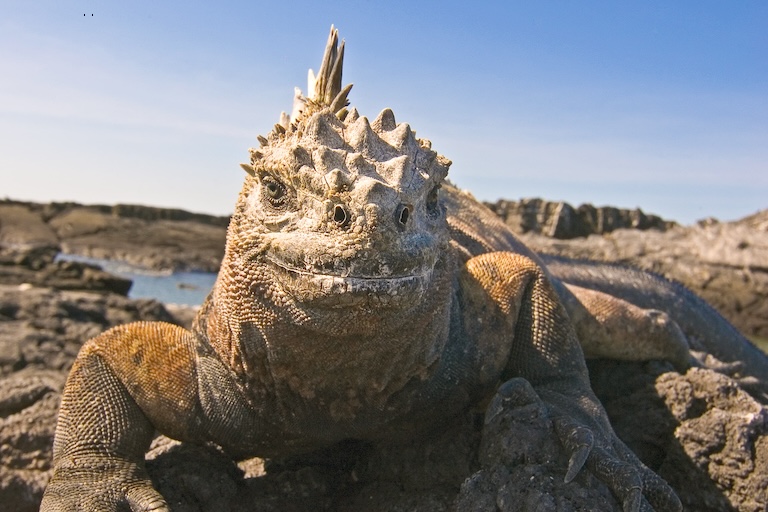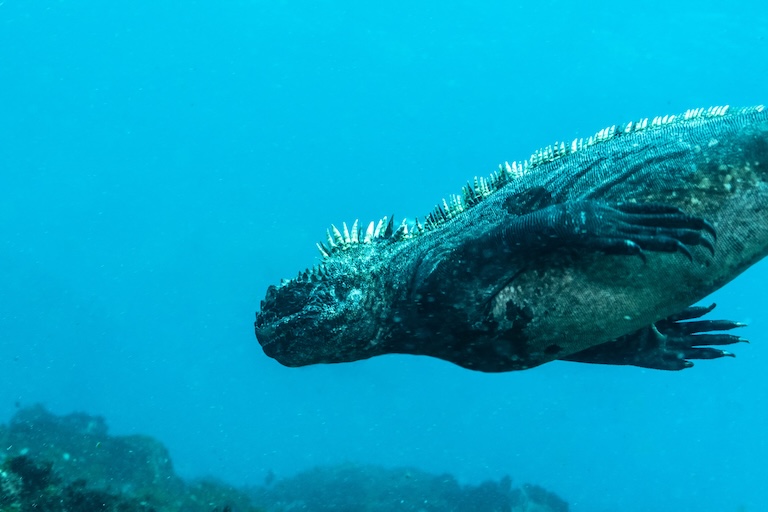Marine Iguana Profile
Lizards have been around for about as long as dinosaurs were. They arrive in the fossil record about 10 million years after the first dinosaurs and have certainly outlasted most of the big ones. Since then, they have evolved into some very cute and very terrestrial animals.
All except the marine iguana.
These lizards have an unfair history of documentation, being described as ugly, inedible, disgusting and clumsy, even by Darwin, yet they are the only lizards that can do what they do.
Also, they look like Godzilla.

Marine Iguana Facts Overview
| Habitat: | Marine, coastal |
| Location: | Galapagos islands |
| Lifespan: | Up to 60 years (more commonly 12) |
| Size: | Up to 55cm (22 inches) long, with a tail of 84cm (33 inches) long |
| Weight: | Up to 12kg |
| Colour: | Mostly black, with fiery bellies |
| Diet: | Red algae |
| Predators: | Snakes, hawks, sharks |
| Top Speed: | 3.4 km/h (2 mph) |
| No. of Species: | 1 |
| Conservation Status: | Vulnerable (IUCN) |
Marine Iguanas are the only marine lizards left. They can grow to impressive sizes, too. But astonishingly, they can shrink back down if they have to.
These bizarre animals live in some tough conditions and have adapted accordingly, feeding on algae as deep as 30 meters into the ocean.
Sadly, they never evolved to fear humans or other predators, so they are at risk of decline from introduced species, but with a little help, they stand a good chance of recovery.
Interesting Marine Iguana Facts
1. They’re different from the landlubber iguanas
While they look very similar – and are in the same family – as the commonly found land-based cousin with the same name, marine iguanas are thought to be at least 4.5 million years apart from their greenhorn relatives.
They’re genetically close enough to have offspring, but the offspring are infertile. This hybridisation does occasionally happen but it’s a shameful act in iguana society and isn’t spoken of.
This means they diverged at a time around the moment the Galapagos islands they now inhabit were being invented. They were likely on some kind of volcanic archipelago that became flooded and ran out of food, so these iguanas made the best of a bad situation and took to the water.

2. They’re the only marine lizard
And somehow these are the only lizards who figured this out. Perhaps the land is just plenty comfortable for other species, or the ocean is just far too scary, but of all the lizard species on Earth, the marine iguana is uniquely a marine species.
The islands they inhabit are pretty barren, and the small amount of plant life brought aboard them is usually heavily guarded by cormorants who have brought it onto land to use as nesting materials. So marine iguanas have perfected the art of wiggling elegantly through the water like a crocodile to dive to regions of seaweed on rocks and eat that instead.
But not everyone is bold enough to do this. It’s usually the stronger, larger males who go on dives; females and juveniles are content to settle for the low tide line, picking off algae that haven’t yet been nabbed by the cormorants.
They can thank the power of the Cromwell current for this, which brings nutrient-rich and oxygenated water up to the islands and creates a habitat for algae to thrive.
3. They’re fantastic swimmers
Big males can dive to a depth of 30 m and stay there for up to an hour. This is unusual, and most dives are significantly shallower and shorter in duration than this, especially when it’s the smaller adults dabbling in the shallows at the tide mark.
But where these lizards lack grace on land, they make up for it in the water. They’re not fast, at around 3km/h, but they are elegant. They use a serpentine motion with a lot of tail propulsion, like a crocodile, to travel through the water, and enormous talons to grip and hold onto rocks while they’re down there.
Still, they’re lizards, and they like to ride at a comfortable body temperature of about 35 to 39 degrees Celsius, which is not likely to happen while submerged, and this is one of the key dangers of such a lifestyle.
The water they swim in can be as cold as 11 degrees Celsius, and this puts them at risk of cold-stunning – a phenomenon where the marine reptile becomes paralysed by the cold and at risk of drowning. 1

4. There’s a huge variation in their sizes
These animals are remarkably adaptable at the physiological level. The largest of them reach up to around 12kg, while the smallest sit comfortably at around 1kg in weight, usually in populations who live on islands where there is less food.
Strangely, this isn’t a genetic adaptation but a physiological one. Individuals can even shrink themselves down by 20% in cases of extreme scarcity, such as during El Niño, and return to their former size once the troubles have passed.
And this isn’t just fat loss – in fact, marine iguanas can lose bone, too. 2
5. They can absorb their own bones
Deaths to starvation in marine iguanas are common during severe fluctuations in the algal communities they feed on.
The largest animals starve first, followed by the next in size, and as you’d expect, this creates a smaller population overall, but there’s more to it than this.
Those who survive long enough can shrink in body length within just a few months, a process that involves reabsorption of bone tissue. This is an incredible adaptation to starvation that isn’t yet fully understood.
But researchers and iguanas both have a lot to learn.

6. They’re naïve
On many islands, you can (but you shouldn’t) walk right up to a large animal and crack it on the head with a club. This is because for an evolutionarily significant amount of time that species has been sitting there minding its own business in the conspicuous absence of people with clubs and never learned to be wary of such a thing.
This is how the dodo met its fate, compounded by the presence of introduced animals like pigs dogs, cats and rats, all of which the marine iguana – a similarly ecologically naïve species is now facing.
Thankfully, men with clubs are a much smaller threat than they were in the 1600s and the iguanas are heavily protected against that particular threat, but introduced predators are a genuine danger to the iguanas.
Still, the danger isn’t as great to marine iguanas as it is to many of the smaller and less frightening animals on the islands, so their decline is mercifully slower than that of some. They are currently listed as threatened by the IUCN>.
7. They Lek
As if one record wasn’t enough, these animals are the only lizards to use the Lek system of mating. Dominant males defend territories and gather as many females to them as possible.
A single male using this system can be responsive for a third or more of the copulations that occur. Roaming bands of inferior males patrol the perimeters of these territories and try to rush in for a quickie with a female when nobody is looking, but they are seldom able to get a leg over. 3
Marine Iguana Fact-File Summary
Scientific Classification
| Kingdom: | Animalia |
| Phylum: | Chordata |
| Class: | Reptilia |
| Order: | Squamata |
| Family: | Iguanidae |
| Genus: | Amblyrhynchus |
| Species: | Cristatus |
Fact Sources & References
- BBC Earth (2010), “Swimming Marine Iguanas”, YouTube.
- “Marine Iguana”, IUCN Red List.
- MARTIN WIKELSKI (1996), “Lekking in marine iguanas: female grouping and male reproductive strategies”, Science Direct.
